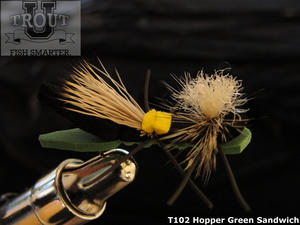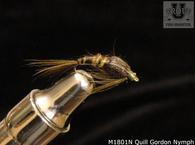
When thinking about fly selections, I am always thinking ahead by at least one month. Currently I am thinking about the hot summer months which are already here in the Smokies; and summer will soon be approaching the higher levations such as the Yellowstone National Park. I am thinking terrestrials right now.
Terrestrial insects by definition are insects that are born or living on land rather than in the sea or the air. The only time that terrestrial insects get into the water is by accidentally falling or accidentally landing or by being washed into the water. The common grass hopper is an important food for trout most anywhere there is some vegetation, but especially where the stream flows through meadows filled with grass or weeds. Some of the Yellowstone National Park’s huge meadows like those found near the Madison River are ideal for terrestrials especially the grass hopper. Also, I had a “field day” in the Cataloochee River in the Great Smoky Mountains National Park one summer just as the men were mowing the grass in the meadows.
Grass hoppers can vary greatly in size and in appearance, however, that does not seem to make a difference to the trout. The obvious main season for grass hoppers is naturally the summer and early fall prior to the first frost, which happens to be when the normal aquatic insect hatches have diminished. Occasionally a few will survive a frost or two. Most grass hoppers rely on their strong legs to take off about as much as they do their wings. Once airborne, the grass hoppers tend to fly haphazardly, flying only a short distance and landing wherever they happen to be including in the water. This characteristic makes them a prime source of food for trout in late summer and in some instances they can become the main source of food during that period.
My sense is that the trout are not selective about the species or the colors since a wide variety of them exist in any one area. We suspect that the biggest variable may be in the size of the hopper and you should observe the population of grass hoppers near your stream prior to choosing the correct size fly. Therefore, we at Trout University offer just one grass hopper pattern in the “Perfect Fly” series, but we offer several different hook sizes in that pattern.
We don't want to leave the impression that matching the hoppers isn't necessary at all. The closer your fly is to the naturals along a stream the better off you are. If the water is smooth and clear, a good imitation may help. That is why we sell Dave's hoppers. I doubt anyone could improve on that fly very much. We haven't even tried to do so.
Presentation:
The best method of mimicking a grass hopper is to catch one and throw it into the water. Observe the motions the hopper will make as it tries in vain to escapes the waters. Without the use of it’s feet, it is helpless to get airborne. The best approach is to fish parallel to and close to the banks exercising care to not spook the trout but you need not be concerned about making a splash since the real thing makes a splash. Do try to give the fly some action from time to time to keep it lively.
Another method of fishing the hopper is to use it on the surface with a #22 or #24 nymph dropper fly tied on. This will take advantage of the fact that there are populations of midge larva and young caddis larva as well as young mayfly and stonefly nymphs in the streams. The “perfect Fly” Sandwich Hoppers were designed with foam so they will float high in the water while supporting the nymph pattern. Most importantly, the Green Sandwich Hopper will be an effective strike indicator, but it also gives you two opportunities for a strike.





